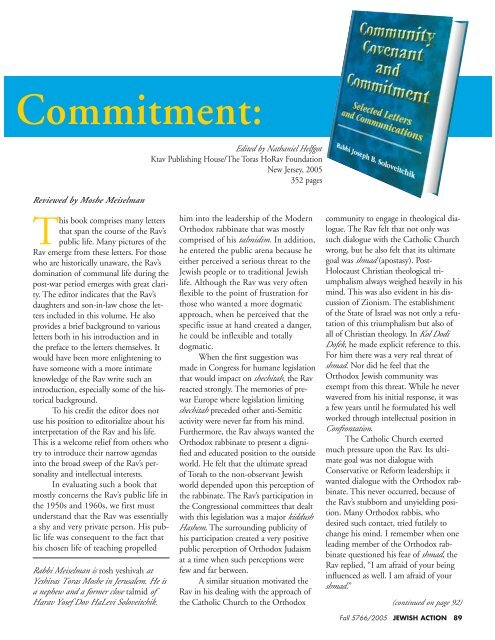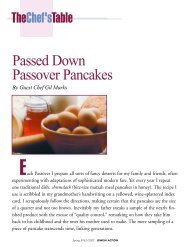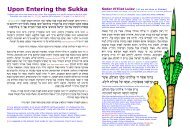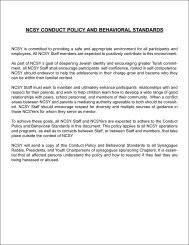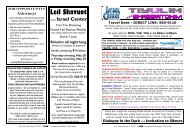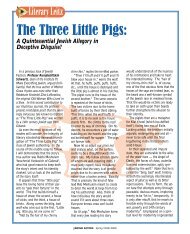Commitment: - Orthodox Union
Commitment: - Orthodox Union
Commitment: - Orthodox Union
Create successful ePaper yourself
Turn your PDF publications into a flip-book with our unique Google optimized e-Paper software.
<strong>Commitment</strong>:<br />
Reviewed by Moshe Meiselman<br />
Edited by Nathaniel Helfgot<br />
Ktav Publishing House/The Toras HoRav Foundation<br />
New Jersey, 2005<br />
352 pages<br />
This book comprises many letters<br />
that span the course of the Rav’s<br />
public life. Many pictures of the<br />
Rav emerge from these letters. For those<br />
who are historically unaware, the Rav’s<br />
domination of communal life during the<br />
post-war period emerges with great clarity.<br />
The editor indicates that the Rav’s<br />
daughters and son-in-law chose the letters<br />
included in this volume. He also<br />
provides a brief background to various<br />
letters both in his introduction and in<br />
the preface to the letters themselves. It<br />
would have been more enlightening to<br />
have someone with a more intimate<br />
knowledge of the Rav write such an<br />
introduction, especially some of the historical<br />
background.<br />
To his credit the editor does not<br />
use his position to editorialize about his<br />
interpretation of the Rav and his life.<br />
This is a welcome relief from others who<br />
try to introduce their narrow agendas<br />
into the broad sweep of the Rav’s personality<br />
and intellectual interests.<br />
In evaluating such a book that<br />
mostly concerns the Rav’s public life in<br />
the 1950s and 1960s, we first must<br />
understand that the Rav was essentially<br />
a shy and very private person. His public<br />
life was consequent to the fact that<br />
his chosen life of teaching propelled<br />
Rabbi Meiselman is rosh yeshivah at<br />
Yeshivas Toras Moshe in Jerusalem. He is<br />
a nephew and a former close talmid of<br />
Harav Yosef Dov HaLevi Soloveitchik.<br />
him into the leadership of the Modern<br />
<strong>Orthodox</strong> rabbinate that was mostly<br />
comprised of his talmidim. In addition,<br />
he entered the public arena because he<br />
either perceived a serious threat to the<br />
Jewish people or to traditional Jewish<br />
life. Although the Rav was very often<br />
flexible to the point of frustration for<br />
those who wanted a more dogmatic<br />
approach, when he perceived that the<br />
specific issue at hand created a danger,<br />
he could be inflexible and totally<br />
dogmatic.<br />
When the first suggestion was<br />
made in Congress for humane legislation<br />
that would impact on shechitah, the Rav<br />
reacted strongly. The memories of prewar<br />
Europe where legislation limiting<br />
shechitah preceded other anti-Semitic<br />
activity were never far from his mind.<br />
Furthermore, the Rav always wanted the<br />
<strong>Orthodox</strong> rabbinate to present a dignified<br />
and educated position to the outside<br />
world. He felt that the ultimate spread<br />
of Torah to the non-observant Jewish<br />
world depended upon this perception of<br />
the rabbinate. The Rav’s participation in<br />
the Congressional committees that dealt<br />
with this legislation was a major kiddush<br />
Hashem. The surrounding publicity of<br />
his participation created a very positive<br />
public perception of <strong>Orthodox</strong> Judaism<br />
at a time when such perceptions were<br />
few and far between.<br />
A similar situation motivated the<br />
Rav in his dealing with the approach of<br />
the Catholic Church to the <strong>Orthodox</strong><br />
community to engage in theological dialogue.<br />
The Rav felt that not only was<br />
such dialogue with the Catholic Church<br />
wrong, but he also felt that its ultimate<br />
goal was shmad (apostasy). Post-<br />
Holocaust Christian theological triumphalism<br />
always weighed heavily in his<br />
mind. This was also evident in his discussion<br />
of Zionism. The establishment<br />
of the State of Israel was not only a refutation<br />
of this triumphalism but also of<br />
all of Christian theology. In Kol Dodi<br />
Dofek, he made explicit reference to this.<br />
For him there was a very real threat of<br />
shmad. Nor did he feel that the<br />
<strong>Orthodox</strong> Jewish community was<br />
exempt from this threat. While he never<br />
wavered from his initial response, it was<br />
a few years until he formulated his well<br />
worked through intellectual position in<br />
Confrontation.<br />
The Catholic Church exerted<br />
much pressure upon the Rav. Its ultimate<br />
goal was not dialogue with<br />
Conservative or Reform leadership; it<br />
wanted dialogue with the <strong>Orthodox</strong> rabbinate.<br />
This never occurred, because of<br />
the Rav’s stubborn and unyielding position.<br />
Many <strong>Orthodox</strong> rabbis, who<br />
desired such contact, tried futilely to<br />
change his mind. I remember when one<br />
leading member of the <strong>Orthodox</strong> rabbinate<br />
questioned his fear of shmad, the<br />
Rav replied, “I am afraid of your being<br />
influenced as well. I am afraid of your<br />
shmad.”<br />
(continued on page 92)<br />
Fall 5766/2005 JEWISH ACTION 89
Yisrael lo yeshaker (The Eternal One of<br />
Israel does not lie). This clarity and certitude,<br />
so strongly reflected in these letters,<br />
affected thousands of his pupils. We,<br />
generations later, and our descendants<br />
even “a thousand years” from now, are the<br />
beneficiaries of this confidence and<br />
certitude. JA<br />
Notes<br />
1. Arnold Wolf, Shma, 19<br />
September 1975: 295.<br />
2. Between Berlin and Slobodka:<br />
Jewish Transition Figures From Eastern<br />
Europe (New Jersey, 1985), 197.<br />
3. Ishim Veshitot<br />
(Tel Aviv, 1966), 64.<br />
4. 1, pp. 3-10.<br />
5. 12, pp. 110-113.<br />
6. 20, p. 140. In another letter (18,<br />
pp. 133-136), the Rav writes, “It would<br />
be better not to hear the shofar than to<br />
enter a synagogue whose sanctity has<br />
been profaned.”<br />
7. 14, p. 119.<br />
8. 11, pp. 93-105.<br />
9. 9, p. 83.<br />
10. 10, p. 91. This verse from<br />
Isaiah 60:5 was also used by Rav<br />
Avraham Yitzchak HaKohen Kook in his<br />
speech at the opening ceremony of The<br />
Hebrew University of Jerusalem in 1924.<br />
11. 10, p. 91.<br />
12. 38, p. 206.<br />
13. 37, pp. 203-204.<br />
14. 36, p. 202.<br />
To advertise in<br />
the Winter issue of<br />
Jewish Action<br />
Contact: In the US<br />
Deborah Lieber<br />
212-613-8135<br />
lieberd@ou.org<br />
92 JEWISH ACTION Fall 5766/2005<br />
Moshe Meiselman<br />
(continued from page 89)<br />
The few letters in the volume<br />
regarding the issue of the Synagogue<br />
Council are but a tip of the iceberg of<br />
one of the major issues in <strong>Orthodox</strong><br />
Jewish life of the fifties. Unfortunately,<br />
the time has not yet come when the<br />
background and details of this controversy<br />
can all come to the fore. In 1956, a<br />
letter was signed by eleven of the leading<br />
roshei yeshivah of the United States forbidding<br />
participation in rabbinic or synagogue<br />
groups together with members of<br />
the Conservative and Reform movements.<br />
This would have meant that<br />
members of the Rabbinical Council of<br />
America (RCA) could no longer be<br />
members of the Board of Rabbis—a<br />
mixed group—and that the <strong>Orthodox</strong><br />
<strong>Union</strong> would no longer be able to continue<br />
its longstanding affiliation with the<br />
Synagogue Council of America. The letters<br />
of the Rav in this volume reflect that<br />
the publication of the issur (prohibition)<br />
of the eleven roshei yeshivah came as a<br />
surprise to the Rav. In the time immediately<br />
preceding the publication of the<br />
issur there was an intense dialogue<br />
between the Rav and Rav Aharon Kotler<br />
on reaching a compromise text, to which<br />
the Rav could be a signatory. Both of<br />
these gedolim were interested in avoiding<br />
the divisions within the <strong>Orthodox</strong> community<br />
that would result from the lack<br />
of a compromise. There were two other<br />
individuals whose political interests were<br />
served by a lack of compromise. These<br />
individuals published the earlier text,<br />
thereby aborting the dialogue about a<br />
compromise text. The Rav never forgave<br />
these two individuals for creating the<br />
unfortunate tensions and acrimony that<br />
resulted from the lack of a compromise<br />
text. One can debate whether the<br />
<strong>Orthodox</strong> community gained anything<br />
from the participation of the RCA in the<br />
Synagogue Council. However, the isolation<br />
of the Rav from the rest of the<br />
yeshivah world as a result of this controversy<br />
was certainly a tragedy that greatly<br />
limited his participation in, and impact<br />
on, the general yeshivah world.<br />
This review is certainly not the<br />
venue for a total discussion of the Rav’s<br />
position on Zionism. However, whereas<br />
one quarter of the book revolves around<br />
this, one must draw some conclusions<br />
from a few of the letters. The Rav was<br />
firmly opposed to all changes in the siddur.<br />
The letters discuss this both in<br />
response to the Holocaust and to the<br />
State of Israel. There were two reasons<br />
for this opposition. First, as he points<br />
out (p. 120) prayer is speaking to God,<br />
and much of the current liturgical
changes are statements addressed to ourselves or to an audience,<br />
but they are not proper prayers addressed to God.<br />
Second, the text of prayers reflects takkanot of the Anshei<br />
Knesset Hagedolah or of the Rishonim and cannot be trifled<br />
with. When, after the Six-Day War, there were suggestions to<br />
eliminate Nacheim from the Minchah service of Tishah B’Av,<br />
the Rav reacted strongly. Rebuilding the Old City of<br />
Jerusalem, he said, cannot rectify the destruction—the churban—described<br />
therein. The destruction detailed in Nacheim<br />
is the destruction of the sanctity of Jerusalem and Har Habayit<br />
that will persist until the rebuilding of the Beit Hamikdash. I<br />
asked him, how can we recite the phrase “vayeval’uhoh ligionot<br />
(Jerusalem is swallowed up by legions of a foreign army)?” In<br />
other words, how can we state that Jerusalem is occupied by a<br />
foreign army, when it is not? The Rav answered that whereas<br />
Chazal made such a takkanah, it can only be revoked by a<br />
Sanhedrin. Hence, he said, Chazal understood that until the<br />
coming of Mashiach, Har Habayit would be under the control<br />
of a foreign army. This prescient description of the current situation<br />
came from a deep belief in the words of Chazal. The<br />
Rav’s famous outburst on Yom Ha’atzamaut 1978 when he<br />
called the ceremony for Yom Ha’atzamaut “acute halachic<br />
mental retardation [sic!],” was a result of a deeply held antagonism<br />
to all changes in the siddur.<br />
The Rav’s hesitation to take the office of Chief Rabbi of<br />
Israel was a multi-dimensional one. A major factor was that<br />
ultimately it meant becoming a rav mitaam, a governmentappointed<br />
rabbi. This emerges clearly from the letters. The<br />
downward spiral of the Chief Rabbinate into the political position<br />
it has become today, rather than the spiritual position<br />
originally hoped for, certainly confirms all of his fears.<br />
Professor Yeshaya Leibowitz often repeated a conversation that<br />
he had had with David Ben-Gurion. He asked Ben-Gurion<br />
why he insisted on a Chief Rabbi when he had nothing but<br />
contempt for rabbanim. Ben-Gurion answered that he realized<br />
that a Chief Rabbinate was inevitable. However, this way he<br />
would control it. That is why the Rav turned down the<br />
position.<br />
In a conversation that I had with the Rav during the<br />
period when he was considering the position, he mentioned to<br />
me en passant that, due to all of the tensions in the position,<br />
he was sure that the next Chief Rabbi would be fired before<br />
the end of his term. As a naïve young man, I argued with him<br />
that such a thing was unthinkable. When Rabbi Isser Yehudah<br />
Unterman, who became Chief Rabbi, was ultimately dismissed<br />
from his position to make place for Rabbi Shlomo Goren, I<br />
realized chacham odif minavi.<br />
An important aspect of the Rav that emerges from all of<br />
his letters is his desire not to have the <strong>Orthodox</strong> Jewish community<br />
marginalized and ghettoized. He saw great value in the<br />
full visual participation of an educated <strong>Orthodox</strong> laity in all<br />
aspects of American life. This was a constant theme of many of<br />
his activities. One can see this in Chomesh Drashos and in the<br />
herein published letters about the Mizrachi movement.<br />
Anyone who spoke to him heard this as a recurring theme of<br />
all of his conversations. He often said that we have to bring<br />
Torah from the reshut hayachid to the reshut harabim (from the<br />
private to the public domain).<br />
The letter about Albert Einstein College of Medicine is a<br />
case in point. The Rav asserted that he was dealing with a<br />
bedieved situation but went on to describe what positive results<br />
could emerge from such a school under the auspices of Yeshiva<br />
University. He identified two such consequences. One, that it<br />
will enable <strong>Orthodox</strong> Jewish young men to enter the medical<br />
profession without compromising their principles. Two, it will<br />
produce the visible educated <strong>Orthodox</strong> Jewish laity that the<br />
Rav so longed for. However, he asserted that all of this<br />
demanded “that the Yeshiva will have full spiritual and religious<br />
control over the direction of the school and the administration<br />
of the Yeshiva will stand guard to ensure that no religious<br />
principle will be compromised. … ad hoc desecration of<br />
Shabbat must also not be condoned or permitted.” Whereas<br />
the <strong>Orthodox</strong> Jewish community has progressed since the<br />
fifties and most major medical schools accommodate those<br />
who keep Shabbat and mitzvot, one wonders whether the Rav’s<br />
dream is being realized or violated.<br />
The Rav’s position on the learning of Torah Shebe’al Peh<br />
by women is referred to in two letters. The halachic brief on<br />
the topic that the Rav promised to write never happened. This<br />
has given many people, unfamiliar with the Rav, license to<br />
engage in speculation as to his position and to ascribe to the<br />
Rav conclusions drawn of their speculation. The Rav did not<br />
belief in the unisex approach that claims that women and men<br />
share the same psychological make-up and roles. He wrote that<br />
it is the father’s task to instill in his child “discipline of thought<br />
as well as … discipline of action.” It is the mother’s task to<br />
teach the child to “feel the presence of God … to appreciate<br />
mitzvot and spiritual values, to enjoy the warmth of a dedicated<br />
life.” He felt that the discipline of thought that is necessary<br />
in halachic development was the male province. However, he<br />
balanced this with a different concern. He was afraid that people<br />
who viewed halachah as “random and arbitrary” would<br />
never be committed to proper halachic observance. By exposing<br />
them to Talmud, they would be appreciative of the sophistication<br />
of halachah and the halachic process. When he gave<br />
his introductory shiur in Talmud at Stern College for Women,<br />
he reiterated this position in the car on the way home. He said<br />
that the teaching of Talmud would be a “springboard to<br />
expose them (i.e., the students of Stern) to the masa u’matan<br />
of the Torah Shebe’al Peh” and that “exposure to Torah<br />
Shebe’al Peh would show them that the halachic process is not<br />
random and they would see the sophistication in Torah as in<br />
other areas.”<br />
It is interesting to note that in the Rav’s entire advocacy<br />
of the learning of Talmud for women, he never introduced<br />
them to the study of Nashim and Nezikin, the areas that he<br />
spent most of his time teaching to men. He restricted their<br />
exposure to Moed, Berachot and Chullin. Since the goal was to<br />
Fall 5766/2005 JEWISH ACTION 93
develop an appreciation of the halachic process, he restricted<br />
their exposure to those areas that have practical halachic relevance.<br />
The attempt to equate men and women in the<br />
approach to the learning of Torah, and the consequent desire<br />
to produce posekot, is alien to the Rav’s goals. The Rav had definite<br />
practical goals in his introduction of women to the study<br />
of Talmud. He never meant to equate the mitzvah of Torah<br />
study for men with that for women.<br />
In the summer of 1968, the Rav taught masechet Nazir<br />
in Boston. A woman showed up to one of the shiurim. The<br />
Rav informed her that women were not welcome to these<br />
technical shiurim, even if they sat on the other side of the<br />
mechitzah. She told him that she had traveled all the way from<br />
New York to listen to his shiurim. He said that if she remains<br />
he would stop the shiur. On the following day, when she<br />
showed up again, she stood behind a column to remain unnoticed.<br />
The Rav noticed her in the middle of his shiur and<br />
informed her that unless she left forthwith he would stop the<br />
shiur immediately.<br />
The book contains a letter referring to an early draft of<br />
the essay “uVikkashtem miSham.” This was meant to be a<br />
sequel to the Rav’s essay “Ish ha-halakhah” (Halakhic Man).<br />
After the passing of the Rav’s wife, the Rav returned to that<br />
earlier version and invested much time in further developing<br />
the manuscript. He called it “Ish ha-Elokim.” He gave the<br />
manuscript to a certain individual to have it typed. That person<br />
left it in an attaché case in his automobile in Manhattan.<br />
The car was vandalized and the attaché case stolen. The Rav<br />
was devastated. That night, when he was informed about the<br />
theft, he told me that that manuscript reflected his finest work.<br />
He told me that he would have to go back to the earlier version,<br />
but was not capable of reconstructing the whole piece.<br />
“uVikkashtem miSham” was a minor attempt to reconstruct<br />
“Ish ha-Elokim.”<br />
A full evaluation of all of these letters, especially the<br />
philosophical points and issues raised at the end of the book, is<br />
beyond the scope of a short review. It awaits the honest analysis<br />
of someone deeply familiar with the Rav’s thought—<br />
halachic and religio-philosophical—and his position on all of<br />
the communal issues addressed in these letters. We hope that<br />
such a study will be forthcoming.<br />
In a book of such great historical value one would have<br />
expected that the technical aspects would have been carried<br />
out with greater care. There are typographical errors throughout<br />
the book. Sometimes, the errors are such as on page 315,<br />
where the word Talmudist is spelled Tamludist. Sometimes, it<br />
is as we find on page 334 where the word fellow has a clear<br />
misprint. On page 151, Brooklyn is written Broo16lyn. These<br />
are three examples of many places where a lack of care in the<br />
technical preparation of the book is evident. In the days of<br />
spell check by computer, such sloppiness should have been<br />
avoided. It is hoped that The Toras HoRav Foundation will<br />
take greater pride in its sacred trust. Hopefully, this situation<br />
will be remedied in the second edition. JA<br />
94 JEWISH ACTION Fall 5766/2005


